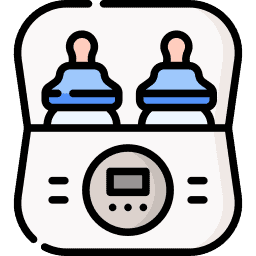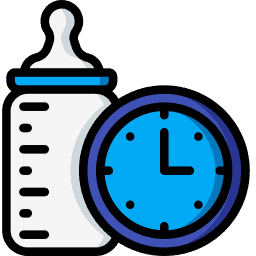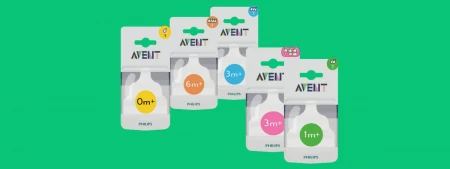You love breastfeeding, but you might need a break. Whether you are returning to work or just want a night out, introducing a bottle gives you freedom.
It also lets your partner bond with the baby during feeding time.
But you might be worried. Will your baby refuse the bottle? Will they get “nipple confusion” and reject the breast later?
Here is everything you need to know about successfully introducing a bottle to your breastfed baby.

Things to Know Before You Start

Introducing a bottle isn’t necessary if you plan to be with your child 24/7. However, most moms do not have that luxury. Being the sole source of food is exhausting, and a baby bottle allows others to help.
There are benefits and drawbacks to introducing a bottle. It is best to weigh them before making your decision.
Pros of Bottle Feeding
- Illness recovery: If you are too sick to breastfeed, you can rest while someone else feeds the baby.
- Work flexibility: You can return to work outside the home without weaning.
- Mom breaks: You can go to a movie or dinner with friends.
- Partner bonding: Your partner can experience the joy of feeding the baby.
- More sleep: A caregiver can handle a night feed so you can catch up on rest.
Cons of Bottle Feeding
- Mom guilt: You might feel like you are “replacing” yourself.
- Nipple confusion: Some babies struggle to switch between flow rates.
- Refusal: Your baby may hate the texture of the artificial nipple.
- Supply dips: If you do not pump when the baby takes a bottle, your supply may decrease.
Myths of Bottle Feeding
The biggest myth is that your baby will never take the breast again.
This is rarely true. Most babies can switch successfully between breast and bottle, especially if you use “paced feeding” techniques. Even if a preference develops, you can usually correct it with patience.
When Can I Introduce a Bottle to a Breastfed Baby?
Timing is everything. If you introduce it too early, you risk interfering with your milk supply establishment. If you wait too long, the baby may reject the artificial nipple entirely.
Timing Is Key
If you wait past the 6-week mark, introduction becomes harder. Older babies are smarter and more stubborn; they know where the “good stuff” comes from and may refuse the plastic substitute.
Choosing the Correct Equipment

You need the right tools for the job. Not all bottles are created equal, and breastfed babies can be picky customers.
How Can I Choose the Right Bottles?
Every baby has a different sucking pattern. What works for your best friend’s baby might fail miserably for yours.
Do not rush out and buy a “starter set” of 10 bottles from one brand. You might spend a fortune only to find your baby hates them.
Top Tip
If the first bottle fails, do not get discouraged. Keep trying different shapes until you find the winner.
How Do I Find the Right Nipples?
The nipple is the most critical part. It should mimic the breast as closely as possible to minimize confusion.
Here is what to look for:
- Wide base: This allows the baby to maintain a wide latch, similar to breastfeeding.
- Gradual slope: Look for a nipple that gradually slopes from tip to base, rather than looking like a distinct nub on a flat ring.
- Soft silicone: Hard nipples feel foreign. Soft silicone mimics skin texture better than latex.
- Slow flow: This is non-negotiable. You must use the slowest flow available (often labeled “Preemie” or “Newborn”) so the baby has to work for the milk, just like at the breast.
What Accessories Should I Have on Hand?
Beyond the bottle, a few tools make the transition smoother.
Consider adding these to your list:
- Bottle Brushes: Hygiene is vital. Get a brush that cleans both the bottle body and the tight spaces inside the nipple.
- Breast Pump: If you are returning to work, you need a high-quality electric pump. This maintains your supply and creates the stockpile your caregiver will use.
- Bottle Sterilizer: While hot soapy water works, a sterilizer offers extra peace of mind against bacteria, especially for younger babies.
- Bottle Warmers: Breast milk comes out of the body at roughly 98 degrees. A warmer ensures the bottle is the perfect temperature every time, which helps with acceptance.
Tips for Introducing the Bottle

You might feel nervous giving that first bottle. It feels different from the warm cuddles of nursing.
Follow these tips to increase your chances of success.
1. Let Your Partner Handle the First Feed
Babies are smart. They can smell your milk. If you try to offer a bottle, they will wonder why you are withholding the “real thing” when it is right there.
Step out of the room, or even the house. Let your partner or a grandparent offer the first bottle. The baby does not associate them with breastfeeding, so they may be more willing to accept an alternative.
2. Watch the Position
Do not cradle the baby exactly like you do when breastfeeding. If you use the exact same position, the baby expects the breast and will get frustrated when they get silicone instead.
Try facing the baby away from the caregiver (looking out at the room) or propped up on knees.
With that said, some babies more readily accept a bottle if nothing about the position reminds them of breastfeeding. Baby’s caregiver can let baby sit in a seat facing them and hold the bottle for baby. Or they can hold baby facing outward with baby’s back against caregivers chest.
Editor's Note:
Michelle Roth, BA, IBCLC3. Start with a Slow Flow Nipple
Breast milk does not spray out like a fire hose continuously; letdown takes time. Standard bottle nipples drip fast.
If the flow is too fast, the baby might choke or get lazy because they don’t have to work for the food. Always use a slow flow nipple to mimic the effort required at the breast.
4. Don’t Go Cold Turkey
Do not switch from 100% breast to 100% bottle overnight. This is a recipe for clogged ducts for you and emotional distress for the baby.
Transition Slowly
5. Mimic Breastfeeding Patterns
Breastfeeding involves pauses. The baby sucks, swallows, and then rests. Bottle feeding often leads to continuous gulping because gravity pushes the milk out.
Every few minutes, tip the bottle down or remove it to give the baby a break. This stops them from guzzling the milk too fast.
6. Watch the Quantity
It is very easy to overfeed a bottle-fed baby (1). The bottle empties faster than the breast, so parents often think the baby is still hungry and offer more.
Remember
Breastfed babies typically take in about 1 to 1.25 ounces per hour they are away from you. A typical bottle size is 3 to 4 ounces. They do not need the large 8-ounce bottles that formula-fed babies might take.
Editors Note
Most lactation consultants now recommend cue-based feeding. Sometimes a baby might take 3 ounces, other times 4. Watch the baby, not the ounces.
7. Watch for Satiety Cues
Your baby will tell you when they are done.
Look for these signs:
- Turning the head away.
- Pushing the bottle out with the tongue.
- Letting milk dribble out of the mouth (playing, not eating).
- Relaxed hands and body.
8. Feed When Hungry, Not Starving
Do not wait until the baby is screaming with hunger to try a bottle. A frantic baby cannot learn a new skill.
Offer the bottle when the baby is showing early hunger cues like smacking lips, rooting, or sucking on hands (2). They will be calmer and more patient with the new equipment.
9. Stay in Close Contact
Breastfeeding is 50% food and 50% comfort.
When bottle feeding, make eye contact. Talk to your baby. Cuddle them close. Ensure they still get that “mommy time” even if the milk is coming from a silicone nipple.
Keep In Mind
Understanding Paced Feeding

Paced feeding is a method of bottle feeding that mimics breastfeeding. It is the “gold standard” for breastfed babies.
This method forces the baby to work for the milk and allows them to control the pace. This prevents “flow preference,” where the baby starts rejecting the breast because the bottle is too easy (3).
✓ How To Do Paced Feeding
- Sit Upright: Hold the baby in a semi-upright position. Do not lay them flat.
- Horizontal Bottle: Hold the bottle horizontally (parallel to the floor). The nipple should be only half-full of milk.
- Invite the Latch: Tickle the baby’s lip with the nipple and wait for them to open wide.
- Frequent Pauses: After 20-30 seconds of sucking, tip the bottle down to stop the flow (keeping the nipple in the mouth) or remove it gently.
- Switch Sides: Halfway through the feed, move the baby to your other arm. This mimics switching breasts and encourages equal eye development.
Bottle Position Note
The Pros of Paced Feeding
- Prevents Overeating: The baby realizes they are full before their stomach hurts.
- Preserves Breastfeeding: It keeps the effort level similar to nursing, preventing bottle preference.
The Cons of Paced Feeding
- Takes Longer: It requires patience; a feed might take 15-20 minutes.
- Caregiver Training: You must teach your daycare provider or babysitter how to do it, as many are used to tipping the bottle vertical.
What If Your Baby Refuses the Bottle?

My baby screamed at the bottle for days. It was stressful, but we eventually cracked the code.
If your baby is on a bottle strike, try these tricks.
1. Let Someone Else Do It
This bears repeating. If you are in the room, the baby wants you. Leave the house for an hour and let your partner handle the feed. The baby might protest, but they are more likely to settle for the bottle if you are physically absent.
2. Leave a Scented Item
Your baby loves your smell. It comforts them.
Leave a t-shirt or scarf you have worn recently with the caregiver. They can drape it over their shoulder while feeding. The familiar scent (4) can calm the baby enough to accept the bottle.
3. Change the Temperature
Breast milk is body temperature. If the bottle is too cold, the baby might reject it.
Use a warmer to get the milk to roughly 98°F. Conversely, if your baby is teething, they might actually prefer chilled milk to soothe their gums. Experiment to see what they like.
4. Taste the Milk
If you have high lipase activity in your breast milk, it can taste soapy or metallic after being stored in the fridge or freezer. It is safe to drink, but some babies hate the taste.
Taste a drop of your stored milk. If it tastes soapy, try scalding fresh milk before freezing it to deactivate the lipase.
5. Coat the Nipple
Squeeze a little breast milk onto the tip of the bottle nipple. When the baby tastes the familiar flavor, they may be more inclined to latch on.
6. Try Motion
Some babies feed better while moving. Try walking around the room, bouncing gently on a yoga ball, or rocking in a glider while offering the bottle. The rhythmic motion can be distracting and soothing.
7. Distraction Feeding
If the baby is intently focused on refusing the bottle, distract them. Go outside, look at a ceiling fan, or have someone make funny faces. While they are looking at something else, slip the bottle in.
8. The Dream Feed
Catch the baby when they are sleepy. Offer the bottle right as they are drifting off for a nap or waking up. In this drowsy state, their sucking reflex is strong, and their stubbornness is low.
9. Cup or Spoon Feeding
If the baby absolutely refuses the bottle and you have to go to work, do not panic.
You can use a small open cup or a soft baby spoon to feed milk. It is messy and slow, but it gets food into their belly until they learn to accept the bottle.
10. The Bait and Switch
Start breastfeeding to get the baby calm and sucking. Once they are in a rhythm, quickly unlatch them and slide the bottle nipple in. They might be confused for a second, but if the milk is flowing, they might just keep going.
What If Your Baby Starts Refusing the Breast?

Sometimes the opposite happens: the baby loves the fast flow of the bottle and gets impatient at the breast.
Here is how to get them back on track.
1. Skin-to-Skin Contact
Strip the baby down to a diaper and place them against your bare chest. This releases oxytocin for both of you (5). It reminds the baby that the breast is a happy, safe place, not just a food source.
2. Limit Bottles When Home
If you are home, try to nurse. If you must supplement, try using a cup or spoon instead of a bottle to reduce the baby’s preference for the artificial nipple.
Try Finger Feeding
 Finger feeding can bridge the gap.
Finger feeding can bridge the gap.
- Tape a small feeding tube (connected to a syringe of milk) to your clean finger.
- Let the baby suck on your finger, pad side up against the roof of their mouth.
- Push the milk slowly as they suck. This trains them to suck properly without the rigid bottle nipple.
3. Ditch the Pacifier
Pacifiers are artificial nipples. If your baby is striking against the breast, remove all artificial nipples for a few days to reset their instinct.
4. Nursing While Sleepy
Just like with bottle refusal, a sleepy baby is often more willing to nurse. Try nursing during the night or right after a nap when their defenses are down.
5. Switch Mid-Feed
If you are bottle feeding, switch to the breast halfway through. The baby is already less hungry and frantic, so they might be more patient with the slower flow of the breast.
6. Stay Calm
Babies sense stress. If you tense up because you anticipate a fight, the baby will tense up too. Take deep breaths. If the baby screams, stop, calm them down, and try again later. Do not force the head onto the breast.
7. Try New Positions
Sometimes a nursing strike is due to physical discomfort (like an ear infection or a sore neck). Try the football hold or side-lying position to see if that helps.
8. Hand Express First
If your baby is impatient for the milk to flow, hand express or pump for a minute until you see the milk letdown. Then latch the baby. They get an instant reward without having to work for the initial flow.
You might even consider pumping until the first letdown starts, and then latching your baby on. Or even just doing some breast massage to ‘prime the pump’ and get milk flow going.
Editor's Note:
Michelle Roth, BA, IBCLCFAQs

If you have a bottle refuser on your hands, do not panic. You are not alone.
Stay consistent, keep calm, and try different tricks.
I never thought my daughter would take a bottle, but eventually, she did. We both survived, and I was able to return to work knowing she was fed and happy.
It takes practice, but you and your baby will figure this out together.

















